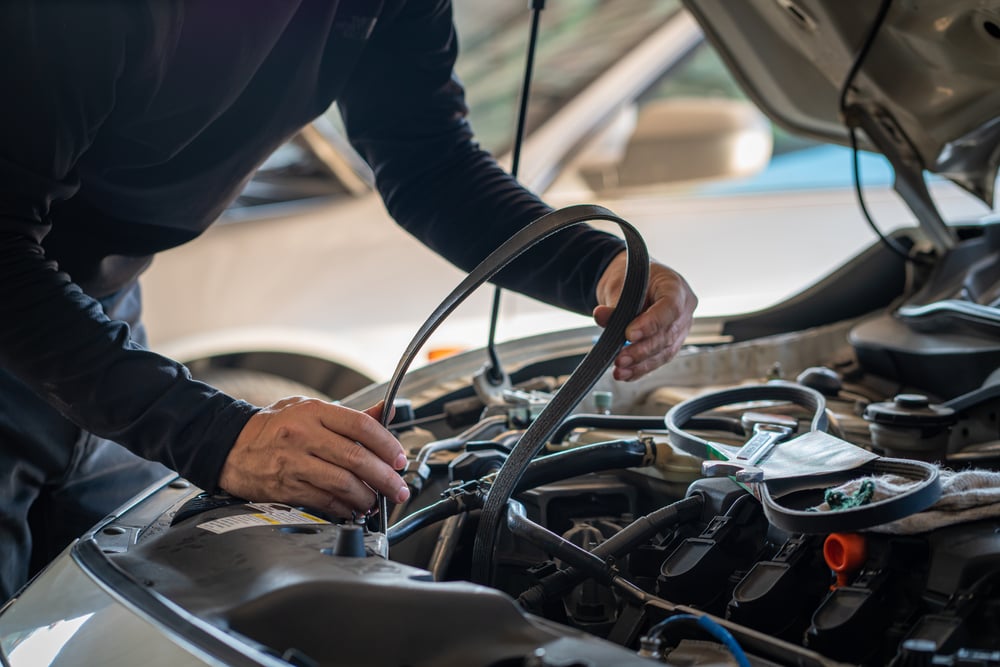When it comes to cars, there are two important belts that help the engine work well: the serpentine belt and the timing belt.
The serpentine belt makes sure things like the air conditioning and charging system work, while the timing belt helps the engine’s parts move at the right time.
In this article, we’ll learn about the differences between a serpentine belt and a timing belt and other important information about the two.
So, let’s dive in and discover how the serpentine belt helps different car parts run smoothly and how the timing belt makes sure the engine works in a coordinated way!
What Is a Serpentine Belt?
A serpentine belt is a really important part of a car’s engine. Imagine it like a long, twisty strap that helps make many things in the car work smoothly. This belt is named “serpentine” because it looks like a snake as it winds around various parts of the engine.
Now, you might wonder what this belt does. Well, it’s like the conductor of an orchestra. Just like a conductor directs musicians to play their instruments at the right time, the serpentine belt makes sure different parts of the car’s engine work together in harmony. It’s responsible for running systems like the air conditioning, power steering, and the charging system, which keeps the battery charged up.
This belt might be only one piece, but it has a big job. It’s in charge of turning all these different parts at the right speed so the car works properly. As the engine runs, the serpentine belt turns and twists, making sure everything stays connected and in sync.
But like anything that’s used a lot, this belt can wear out over time. That’s why it’s important for mechanics to check it regularly. If they see it’s getting old and worn, they’ll recommend replacing it. By doing this, the car can keep running smoothly, and all the different systems that rely on the serpentine belt can keep doing their jobs without any hiccups.
When Should You Replace the Serpentine Belt?
Replacing a serpentine belt is important to keep your car’s engine running smoothly. There are a few key indicators to watch out for when deciding if it’s time for a replacement. If you see cracks, fraying, or a shiny appearance on the belt’s surface, it’s likely that it’s worn out and needs to be changed. Also, if you hear a high-pitched squealing noise coming from the engine area, it’s a clear sign that the belt might be slipping or not working well.
To avoid unexpected issues, it’s wise to follow the manufacturer’s recommendations for when to replace the serpentine belt. These guidelines can usually be found in your car’s owner’s manual.
Even if the belt looks okay, many mechanics suggest changing it every 60,000 to 100,000 miles, which is around 5 to 7 years. This preventive maintenance helps you avoid problems before they happen.
The serpentine belt is essential because it’s responsible for powering various systems in your car, like the air conditioning, power steering, and charging system. If it breaks while you’re driving, these systems can stop working, and your car might even overheat. So, keeping an eye on the belt’s condition and replacing it as needed can save you from unexpected breakdowns and ensure your car continues running smoothly on the road.
What Is a Timing Belt?
This belt might not be as long as the serpentine belt, but its job is just as crucial. The timing belt doesn’t control things like the air conditioning or power steering. Instead, it’s like a controller that tells the engine’s important parts when to move. These parts are called the camshaft and the crankshaft, and they need to move in a perfect rhythm for the engine to work correctly.
Think of the timing belt as a conductor’s baton. It waves at the right time to make sure the camshaft and crankshaft work together like synchronized dancers. When this happens, the engine’s valves open and close at exactly the right moments. This is super important because it helps the engine generate power and run smoothly.
Unlike the serpentine belt, the timing belt doesn’t have to do lots of jobs at once. Its main focus is making sure the engine’s parts are all performing their operation at the right time. If the timing belt doesn’t do its job, the engine can go out of sync, and the car might not run well – or even stop working altogether.
Just like the serpentine belt, the timing belt can get worn out over time. But changing the timing belt isn’t a simple task, and it needs to be done at specific times, usually based on the car’s mileage.
Mechanics keep an eye on it to make sure it’s not getting old and frayed. If it is, they’ll recommend changing it to keep the engine running smoothly and the car moving down the road without any hitches.
When Should You Replace the Timing Belt?
The timing belt should generally be replaced based on your car’s recommended mileage or time interval. Similar to the serpentine belt, mechanics recommend changing the timing belt between 60,000 to 100,000 miles, depending on the vehicle’s make and model. Following the manufacturer’s guidelines is crucial, as neglecting the timing belt replacement can lead to serious engine damage if it fails.

Some cars have timing chains instead of belts, and these typically last longer and require less frequent replacement. However, if your car has a timing belt, you should pay close attention to the recommended replacement schedule.
Additionally, if you notice any signs of wear, cracking, or if the belt becomes noisy, it’s a good idea to have it inspected and replaced if necessary, even if it’s before the recommended interval.
Replacing the timing belt is essential because it controls the timing of the engine’s internal parts, like the camshaft and crankshaft, ensuring they work together smoothly. If the timing belt breaks while the engine is running, it can cause damage to the engine’s valves and pistons, resulting in costly repairs.
To avoid this, staying on top of the timing belt replacement schedule is a smart way to keep your engine running reliably.
What’s the Difference Between the Two?
The serpentine belt and the timing belt might both be belts in a car’s engine, but they have very different jobs. The serpentine belt is like a multitasker – it’s a long, twisting belt that winds around various engine parts, making sure things like the air conditioning, power steering, and charging system all work smoothly together. It’s the conductor of the engine, coordinating different functions.
On the other hand, the timing belt is more like a precise choreographer. It’s not as long as the serpentine belt, but its role is just as critical. Instead of handling many tasks, the timing belt focuses on making sure two important engine parts, the camshaft and the crankshaft, move in perfect synchronization.
This synchronization is crucial because it controls when the engine’s valves open and close. This, in turn, makes sure the engine runs smoothly and generates power effectively.
The timing belt doesn’t multitask like the serpentine belt does – it’s all about making sure the engine’s internal parts are dancing in perfect harmony. If the timing belt were to fail, the engine’s rhythm would be thrown off, and it could lead to serious problems, even causing the engine to stop running.
Another big difference is when these belts need attention. The serpentine belt needs to be checked more often and replaced if it gets worn out since it’s constantly working. On the other hand, the timing belt has a schedule based on mileage. Mechanics keep an eye on it and recommend changing it at specific intervals to avoid potential engine trouble.
Lastly, when you pop the hood of your car, you’ll notice that the serpentine belt is very easy to spot as it wraps around the various parts of your car. However, if you try to look for the timing belt, you likely won’t find it since it is located inside the engine block itself. Accordingly, servicing it can be much more difficult as well when compared to the serpentine belt.
Understanding the Serpentine Belt and Timing Belt
In the world of car engines, knowing about the serpentine belt and the timing belt is really important. As car owners, understanding these differences helps us take good care of our cars. By keeping an eye on the belts and getting them checked and changed when needed, we make sure our cars stay in good shape and work well.
So, whether it’s the serpentine belt conducting different tasks or the timing belt helping the engine run smoothly, both belts are important for our cars. By knowing their jobs and taking care of them, we make sure our journeys on the road stay safe and smooth.


